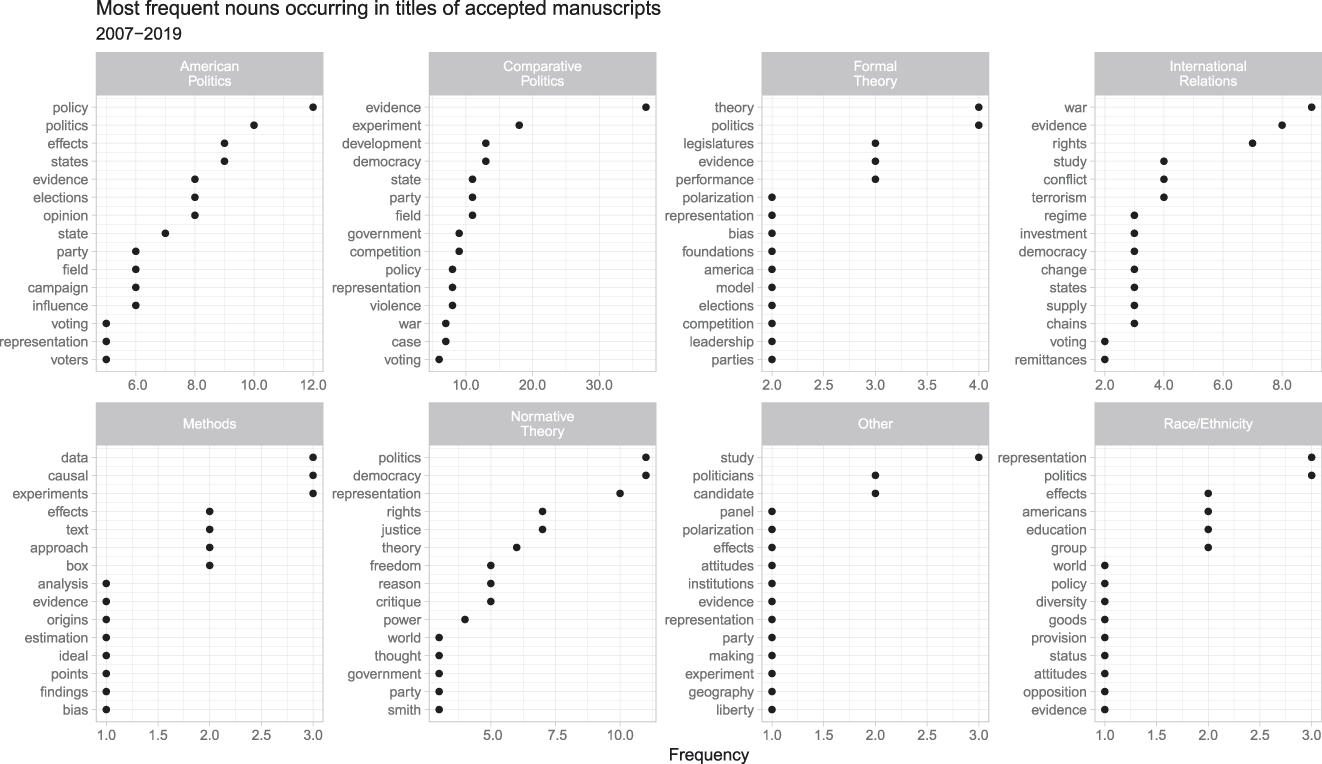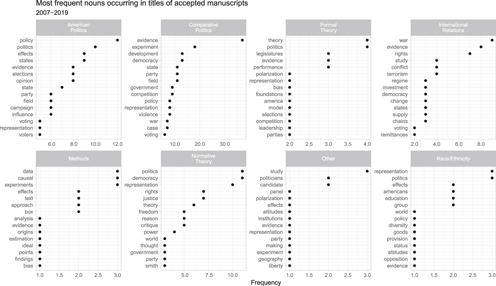The American Political Science Review (APSR) is the premier scholarly outlet of the American Political Science Association (APSA) and understands itself as a generalist journal. As such, we strive to publish research of outstanding merit from diverse topics and methodological approaches aiming to cover all subfields throughout the discipline. Yet, this does not necessarily imply that the articles published in the APSR can (or have to) represent all subfields or even the “best” work a subdiscipline has to offer. The reasons for this are manifold and include, among other things, that some scholars consider other (subfield) journals or books more prestigious than publishing in the APSR (Sigelman Reference Sigelman2006, 463). What is important as an editor, however, is to establish and guarantee a fair and balanced review process, where all participants—authors, reviewers, and editors—benefit in the end. This is not a trivial task as the number of submissions has been significantly increasing over time and subsequently requires finding a corresponding number of reviewers to provide not only their expertise, but also write thorough reports that provide all authors suggestions that improve their research. Nevertheless, concerns about the sampling of articles published in premier scholarly outlets increase with the increasing importance of published articles for professional careers.
Although APSA invites scholars to submit proposals for editing APSR and although the activities of the APSR editors are monitored and scrutinized by the APSA Council’s Publications Policy Committee, concerns about the sampling of articles published in the APSR and the equity of our peer-review process have a long history. On November 4, 2000, the New York Times Footnote 1 published an article about the Perestroika movement, which culminated in an open letter to APSA and later published in PS: Political Science and Politics’ where the signatories asked “why does the APSR and …other prominent fora seem so intensively focused on technical methods at the expense of the great, substantive political questions that actually intrigue many APSA members, as well as broader, intellectual audiences” (Allen et al. Reference Allen2000, 735). The protesters also posited the implication of self-selection, accordingly where “many of the professional leaders do not even read, much less submit to the APSR” and further posits that “APSA Council and APSR editorial board seem[s] to be chosen essentially by their predecessors” (Allen et al. Reference Allen2000, 735).
Ada W. Finifter, the lead editor of APSR at the time, responded in the APSR’s Editor’s Notes in an extraordinary, detailed manner (APSR 2000 94/4, viii–xi). She agreed that many APSR articles use statistical methods and mathematical models, but “not at the expense” of dealing with the great political issues. Furthermore, she remarked on the disciplinary diversity with numerous leaders that establishes our peer-review process as one with a high level of fairness and impartiality and allows a large number of young scholars to develop into professional leaders. Now nearly 20 years later, many of these young scholars are the leaders in their subfields, many of whom partake in the responsibilities of being editors, reviewers, authors, and editorial board members. This leads to another point of editorial board selection and composition also made in Finifter’s response. Our board, like those before it, having followed APSA nomination and selection procedures, currently comprises only a small share of members from the previous editorial team (13 of 73), and of the 60 new board members, consists of 38 women and 22 men.
Like with the Perestroika movement, we receive recommendations on improving the APSR. One such improvement suggests that the sampling of the APSR’s publications should roughly correspond to, if not perfectly mirror, the sections and divisions of APSA. This could translate into a sample of the best papers or paper presentations at quarterly meetings, and could be a more efficient method than our current peer-review process. However, in the APSR’s peer-review process, the emphasis is placed less on mirroring an organizational structure than the success of the individual authors’ ability to overcome the criticism of peers. Because overcoming this criticism may require the use of sophisticated methods and/or theoretical foundations, the sample of published articles does not always reflect organizational patterns. This does not mean that the peer-review process is always perfectly efficient. We have established a process, which attempts to reduce editor bias, e.g., the selection of manuscripts and peers according to editor tastes. Instead of providing individual (subfield) editors with autonomy and discretion, the responsible subfield editor and the lead editor deliberate and decide about manuscripts together. Although the lead editor may not have the special expertise of the subfield editor, she has more general information about decision-making across subfields, which can compensate the informational advantage of the subfield editor.
In addition to these checks-and-balances among editors, all reviewer reports are included in the decision letter to the authors and reviewers, and requires the editors to justify their decision. Because editors, reviewers, and authors may apply different standards, sometimes authors disagree with editors’ decisions and request a re-evaluation of the decision or an allowance to resubmit because their interpretation of the reviewer reports varies from the editors. For editors, however, these reports are often difficult to compare, because reviews provide varying substantive information about the probability that the authors will be able to overcome the criticism in a following round of the peer-review process. Moreover, finding reviewers is one of the most challenging and time-consuming editor activities and overloading peers in times of increasing submissions is one of the riskiest strategies, as this burden can reduce the efficiency of the peer-review process. At APSR, we attempt to lower this risk by imposing a three-month invitation embargo of active peers, which we admit to sometimes breaking when the perfect researcher for a manuscript reviewed in the last three months.
In this Notes from the Editors, we want to address one of the concerns from the open letter which remains relevant today. There continues to be the question of how broad of an audience do the published articles in the APSR reach and how close they represent the wide array of research topics in the general discipline. This is a difficult question to answer, especially because one of the few widely used indicators about the impact of our published articles for other scholars’ professional work comes with a time lag, namely, the impact factors (IF) of two and five years, which essentially measures the average number of citations based on the number of published pieces during the two and five previous years. Accordingly, the current 2018 two- and five-year IFs present data concerning articles first published in 2015–16 and 2012–16,Footnote 2 articles that our current team did not have a hand in publishing. In fact, as our first volume of articles submitted and processed through acceptance was published in February 2018, our “impact” will not be measureable until the 2019 Impact Factor, which will be published in 2020, when we have handed the reigns over to our successors.
So what other ways would be available to us to illustrate our publications’ scope? One could approach it, as the Perestroika movement did, by evaluating whether the sampling of the APSR’s published articles reflect the membership composition of APSA. Unfortunately, membership data are not available to us; but this would be an excellent project for APSA to investigate. Perhaps reviewing the topics represented in the titles of the publications accepted between July 2007 and April 2019 would be an acceptable substitute.Footnote 3 The title of an article should do two things: draw readers attention and classify the topic of study. By focusing on nouns in the title, we can narrow in topics, while removing words that provide less information on the diversity of topics. We extracted the nouns in titles through part-of-speech tagging implemented in the spaCy python package for natural language processing and accessed in R through the package spaCyr (Benoit and Matsuo Reference Benoit and Matsuo2018). For data analysis, we used the quanteda package by (Benoit et al. Reference Benoit, Watanabe, Wang, Nulty, Obeng, Müller and Matsuo2018).
In Figure 1, the word cloud illustrates the diversity of topics covered by the APSR publications and plots the relative frequency of nouns found in article titles that occur at least four times. Word clouds plot relevant feature labels with sizes proportional to their relative frequency.Footnote 4 We use the quanteda package for graphical implementation. In the center, the noun ‘evidence’ is the most pronounced, followed by ‘politics,’ ‘democracy,’ ‘policy,’ ‘representation,’ and ‘state.’ If one would ask respondents from which disciplinary journal these words come, political science is certainly a candidate. This is further supported by the prominence of the nouns ‘elections,’ ‘government,’ ‘party effects,’ ‘voting,’ ‘field,’ ‘war,’ ‘rights,’ ‘theory,’ ‘development,’ and ‘experiment.’ The further one moves from the center, the more specific the keywords become; several topics stick out such as ‘women,’ ‘gender,’ ‘diversity,’ ‘identity,’ ‘inequality,’ and while the words were stipped of context, when they are included among other topics such as ‘formation,’ ‘legitimacy,’ ‘campaign,’ ‘terrorism,’ ‘leadership,’ and ‘regime’ their importance to the APSR becomes striking.

FIGURE 1. Word Cloud with the Most Frequent Nouns in Titles of Accepted Manuscripts (July 2007–April 2019)
To shed further light on topic diversity within subfields, Figure 2 shows the 15 most frequent nouns per subfield. However, in some cases, there were more than 15 words as there were several tied on the lower bound; thus, in these cases, we took a random sample of those words and they appear in the figure. Accordingly, ‘policy’ and ‘politics’ are the two most prominent nouns in American Politics, whereas ‘evidence’ is the clear number one in Comparative Politics. Formal Theory focuses on ‘theory’ and ‘politics;’ International Relations on ‘war,’ ‘evidence,’ and ‘rights;’ Methods on ‘data,’ ‘causal,’ and ‘experiments;’ Normative Theory on ‘politics,’ ‘democracy,’ and ‘representation;’ Other on ‘study;’ and Race and Ethnicity on ‘representation’ and ‘politics.’ Similarly, if we repeat the thought experiment and were to ask respondents in which subfields these words play a prominent role, more than half of the subfields are easily identifiable by the prominence of their topics, although the overlap present across the subfields, continues to suggest that our research interests are still very much bound together.

FIGURE 2. Most Frequent Nouns Occurring in Titles of Accepted Manuscripts per Subfield (July 2007–April 2019)
Our final illustration of the diversity of topics looks at the relative distribution of nouns within subfields. The more diverse the topics within a subfield are, the higher the share of nouns that only occur once should be. This may shed light on concerns about the homogeneity of topics, respectively the onesidedness of articles, which are published in the APSR. Figure 3 shows the share per subfield of nouns that only occur once in an article’s title. According to this graph, the topical diversity is highest among the category “Other.” In turn, the subfield with the highest share of common nouns is Comparative Politics. However, in all subfields, the diversity is relatively high, suggesting a high coverage of different topics in the period of study.

FIGURE 3. Share of Nouns that Only Occur Once in Titles of Accepted Manuscripts per Subfield (July 2007–April 2019)
In these three figures and in our discussion, we hoped to illustrate that the APSR continues to value publishing from all subfields of the social sciences. Given the limited space and rigorous peer review process, we may never be able to mirror the APSA membership, but we do strive to publish state-of-the-art research from all topics. As we move into our final term as editors of this journal, we continue to be open for constructive suggestions that may help us leave this journal in the hands of the next team of capable and passionate editors.






Comments
No Comments have been published for this article.